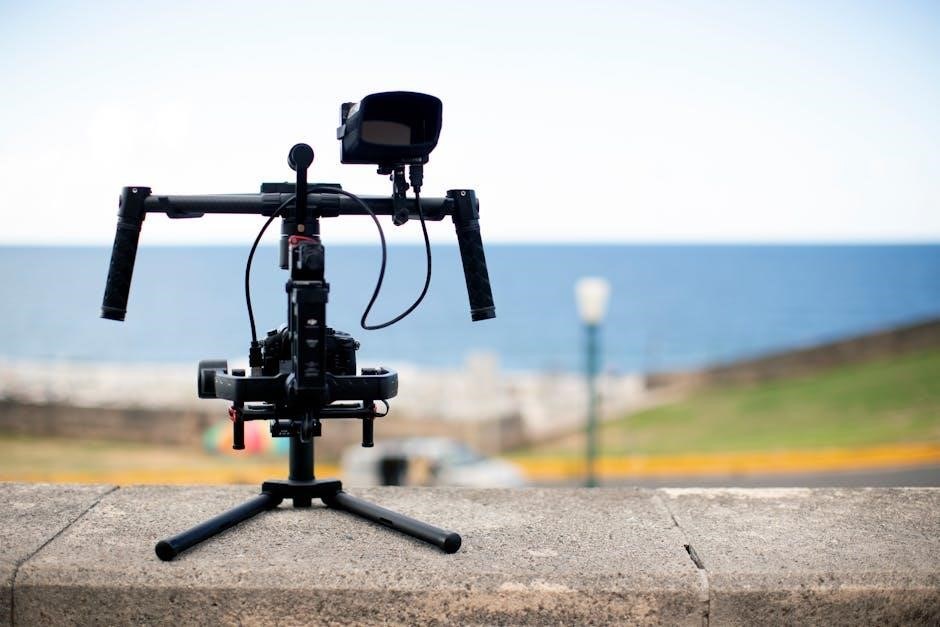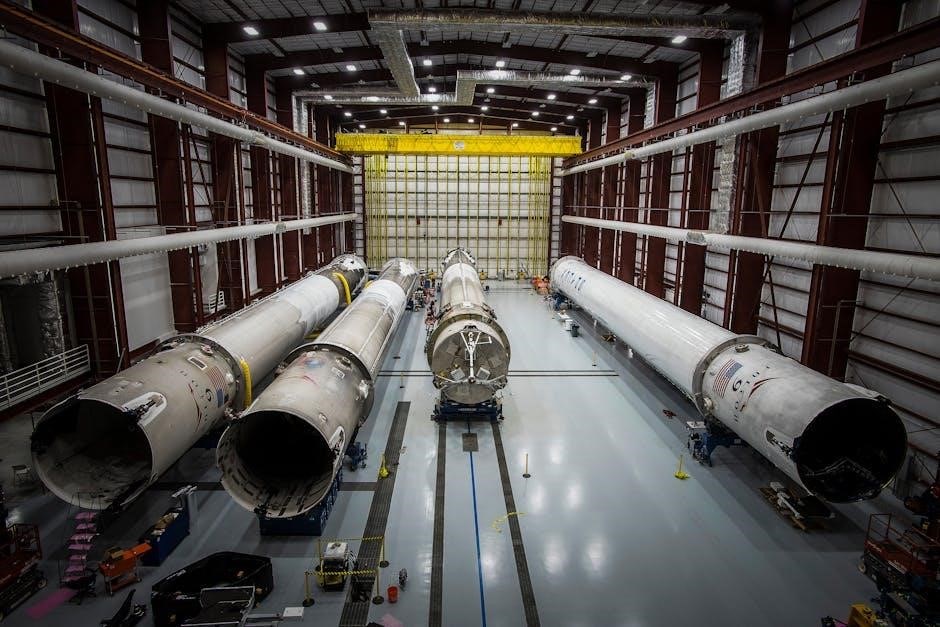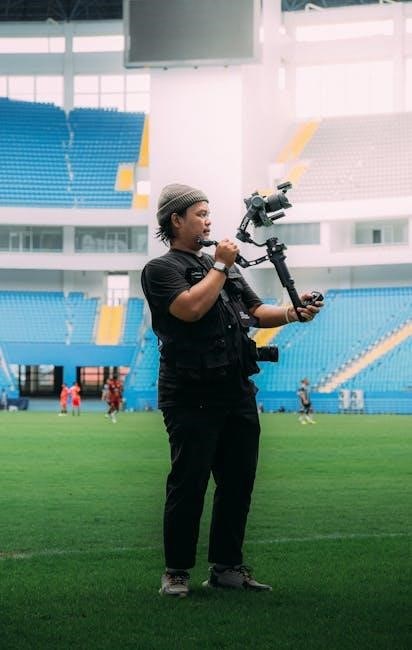The horizontal stabilizer trim system is a critical flight control mechanism that regulates aircraft pitch and stability during flight. Its failure can lead to severe safety risks.
1.1 Overview of the Horizontal Stabilizer Trim System
The horizontal stabilizer trim system consists of mechanical and electronic components, including jackscrews, actuators, and trim wheels, designed to adjust the aircraft’s pitch and maintain stability during flight. Its primary function is to optimize control forces, ensuring efficient and safe flight operations under various conditions.
1.2 Importance of the Trim System in Flight Safety
The horizontal stabilizer trim system is vital for maintaining aircraft pitch control and stability, preventing dangerous conditions like unrecoverable nose-dive scenarios; Its failure can lead to loss of control, emphasizing its critical role in ensuring flight safety and preventing catastrophic accidents.
1.3 Brief History and Evolution of the System
The horizontal stabilizer trim system evolved from manual controls in early aviation to complex, computerized systems. Key advancements include hydraulic actuators and fly-by-wire technologies, enhancing reliability and safety. Modern designs focus on redundancy and automation to mitigate failure risks, ensuring continued safe-flight capabilities.
Causes of Horizontal Stabilizer Trim System Failure
Failures stem from mechanical malfunctions, inadequate maintenance, design flaws, and environmental factors. These issues can lead to system malfunction, compromising aircraft stability and safety during flight operations.
2.1 Mechanical Failures and Component Malfunction
Mechanical failures, such as worn jackscrews or faulty actuators, often lead to trim system malfunctions. Component breakdowns, like failed nuts or gears, disrupt pitch control, risking aircraft stability and necessitating urgent corrective actions to prevent accidents.
2.2 Maintenance Lapses and Inspection Oversights
Inadequate maintenance practices and missed inspections can lead to undetected wear and tear on critical components, such as jackscrews and actuators. Overlooking lubrication and torque checks may result in premature failures, compromising the system’s reliability and increasing the risk of in-flight malfunctions.
2.3 Design Flaws and Manufacturing Defects
Inherent design flaws, such as inadequate material strength or faulty component integration, can predispose the system to failure. Manufacturing defects, like improper assembly or substandard parts, further exacerbate these issues, leading to premature wear and potential catastrophic failures during operation.
2.4 Environmental Factors and External Influences
Environmental factors, such as extreme temperatures, moisture, and icing, can degrade system components. Foreign object damage or contamination may also impair functionality. Additionally, operational stresses from turbulence or flight envelope extremes can accelerate wear, increasing the likelihood of trim system malfunctions during critical phases of flight.

Notable Case Studies of Trim System Failures
Alaska Airlines Flight 261 and McDonnell Douglas MD-83 crashes highlight critical failures, emphasizing the importance of proper maintenance and design integrity to prevent catastrophic outcomes in aviation.
3.1 Alaska Airlines Flight 261: A Case of Jackscrew Failure
On January 31, 2000, Alaska Airlines Flight 261 crashed due to a failed jackscrew assembly in the horizontal stabilizer trim system. The acme nut threads stripped, causing irreversible pitch control loss and tragic consequences, highlighting critical maintenance and design flaws in the system.
3.2 McDonnell Douglas MD-83: Tragic Consequences of Neglect
Insufficient lubrication caused excessive wear in the McDonnell Douglas MD-83’s horizontal stabilizer jackscrew assembly, leading to catastrophic failure. This oversight resulted in a fatal crash, emphasizing the importance of rigorous maintenance protocols and timely inspection of critical flight control systems to prevent such tragedies.
3.3 Boeing 737 MAX: FMEA and System Redundancy
The Boeing 737 MAX incorporated a Failure Modes and Effects Analysis (FMEA) to ensure continued safe flight after a single stabilizer trim system failure. Despite this, system redundancy limitations and MCAS interactions led to tragic consequences, highlighting the need for enhanced redundancy and pilot training in such systems.

Detection and Diagnosis of Trim System Failures
Detection involves advanced sensors, monitoring tools, and routine inspections to identify anomalies. Pilot feedback and flight data recorder analysis aid in diagnosing issues, ensuring timely interventions and enhancing safety.
4.1 Advanced Sensor Systems and Monitoring Tools
Advanced sensors detect mechanical failures in real-time, monitoring position, torque, and system performance. These tools enable early fault detection, reducing risks and enhancing maintenance efficiency. They integrate with flight control systems to provide critical data for predictive maintenance and failure prevention.
4.2 Routine Maintenance and Inspection Protocols
Regular lubrication of jackscrews, thorough inspection of acme nuts, and torque checks are essential. These protocols ensure system integrity, preventing wear and tear that could lead to catastrophic failures. Compliance with airworthiness directives and manufacturer guidelines is crucial for maintaining safety standards.
4.3 Pilot Feedback and In-Flight Anomaly Reporting
Pilots play a vital role in identifying trim system malfunctions through control difficulties or unexpected behavior. Timely reporting of anomalies, such as trim switch failures or MCAS activation, enables prompt diagnostic checks and safety measures, enhancing overall aircraft safety and reliability.

Consequences of Horizontal Stabilizer Trim Failures
Failures can lead to loss of pitch control, aircraft instability, and catastrophic accidents, as seen in cases like Alaska Airlines Flight 261 and the McDonnell Douglas MD-83 crash.
5.1 Loss of Pitch Control and Aircraft Stability
Failure of the horizontal stabilizer trim system can result in the inability to control pitch, leading to aircraft instability and potentially dangerous nose-down or nose-up attitudes, as seen in incidents like Alaska Airlines Flight 261 and the McDonnell Douglas MD-83 crash.
5.2 Increased Pilot Workload and Emergency Procedures
A failed horizontal stabilizer trim system significantly increases pilot workload, requiring immediate attention to regain control. Emergency procedures must be executed swiftly, involving manual trim adjustments and alternative control methods to stabilize the aircraft and prevent further complications.
5.3 Potential for Catastrophic Accidents
Failure of the horizontal stabilizer trim system can lead to catastrophic accidents, as seen in historical incidents like Alaska Airlines Flight 261. Loss of pitch control and stability often results in uncontrollable descents, highlighting the critical need for robust regulatory measures and manufacturer accountability to prevent such disasters.
Prevention and Mitigation Strategies
Robust maintenance practices, adherence to manufacturer guidelines, and advanced monitoring systems are essential to prevent failures. Regular inspections and timely repairs ensure system reliability, minimizing risks of catastrophic events.
6.1 Enhanced Maintenance Practices and Guidelines
Regular lubrication of jackscrew assemblies, thorough inspection of nut threads, and adherence to torque specifications are vital. Implementing predictive maintenance and leveraging sensor data ensures early detection of wear, preventing potential failures. Compliance with airworthiness directives and manufacturer guidelines further enhances system reliability and safety.
6.2 Implementation of Redundant Safety Systems
Implementing redundant safety systems, such as dual actuators and fail-safe mechanisms, enhances reliability. These systems ensure continued functionality even if one component fails. For example, the Boeing 737 MAX incorporates redundancy to prevent single-point failures, while the MD-83’s design lacked such safeguards, highlighting the importance of modern redundant designs.
6.3 Pilot Training and Emergency Drill Emphasis
Comprehensive pilot training is crucial for managing trim system failures effectively. Regular drills and simulations ensure pilots can respond swiftly to emergencies, such as engaging alternative trim controls or executing recovery procedures. This preparedness minimizes the risk of accidents and enhances overall flight safety.
Regulatory and Industry Responses
Aviation authorities issued airworthiness directives, while manufacturers implemented system upgrades to address trim failures, ensuring compliance and enhancing safety standards across the industry.
7.1 Airworthiness Directives and Compliance Measures
Regulatory bodies worldwide have mandated strict airworthiness directives to address horizontal stabilizer trim failures. These measures require enhanced inspections, specific maintenance protocols, and timely component replacements to ensure compliance and mitigate risks effectively, safeguarding aircraft operations and passenger safety.
7.2 Manufacturer Guidelines and System Upgrades
Manufacturers like Boeing and Bombardier have issued specific guidelines and implemented system upgrades to address horizontal stabilizer trim failures. These include enhanced actuator designs, improved monitoring systems, and rigorous testing protocols to enhance reliability and improve overall flight safety.
7.3 Global Aviation Authority Collaboration
Aviation authorities worldwide collaborate to standardize safety protocols and share insights on horizontal stabilizer trim system failures. This collective effort ensures consistent oversight, accelerates implementation of safety measures, and enhances global aviation safety through unified regulations and best practices.

Technological Innovations in Trim System Design
Technological advancements include next-generation actuators, fly-by-wire systems, and smart monitoring, enhancing reliability, efficiency, and safety of horizontal stabilizer trim systems for modern aircraft.
8.1 Next-Generation Actuator Systems
Next-gen actuators use advanced materials and smart technologies to optimize performance, reducing mechanical failures and enhancing reliability. These systems integrate real-time monitoring and adaptive controls, ensuring precise trim adjustments and improved safety in aircraft operations.
8.2 Integration of Fly-by-Wire Technologies
Fly-by-wire systems replace mechanical controls with electronic interfaces, enhancing precision and safety. Real-time monitoring and automated adjustments improve trim system reliability, reducing human error and enabling faster response to anomalies, thereby minimizing failure risks and increasing overall aircraft stability.
8.3 Smart Monitoring and Predictive Maintenance
Advanced sensor systems continuously monitor the trim system’s health, detecting early signs of wear or malfunction. Predictive algorithms analyze data to schedule maintenance, preventing unexpected failures and ensuring uninterrupted system performance, thus enhancing flight safety and reducing downtime effectively.

Human Factors in Trim System Management
Pilot interaction with trim controls and training programs are crucial for effective management, ensuring safe handling of the system and mitigating risks associated with human error during flight operations.
9.1 Pilot Interaction with Trim Controls
Pilot interaction with trim controls is critical for maintaining aircraft stability. Systems like MCAS automate pitch adjustments, but manual trimming requires precise pilot input. Increased workload during emergencies highlights the need for thorough training and situational awareness to manage trim effectively.
9.2 Cognitive Load and Decision-Making Under Stress
During trim system failures, pilots face heightened cognitive load and stress, impacting decision-making. The need to process multiple alarms and procedures simultaneously can lead to errors. Effective training and clear communication protocols are essential to mitigate these challenges and ensure safe flight operations.
9.3 Training Programs for Effective Trim System Handling
Comprehensive training programs are crucial for pilots to master trim system operations. These programs emphasize emergency procedures, workload management, and stress response. Regular simulations and recurrent training ensure pilots can handle trim failures effectively, reducing the risk of accidents and enhancing overall flight safety.
Legal and Liability Implications
Manufacturers may face legal action for trim system failures, with potential lawsuits and regulatory penalties. Passenger compensation claims further complicate liability, emphasizing the need for accountability and compliance;
10.1 Manufacturer Accountability and Litigation
Manufacturers face significant legal and financial consequences for horizontal stabilizer trim system failures. Lawsuits often arise from accidents, with plaintiffs alleging design flaws or negligence. Accountability may involve costly settlements, regulatory penalties, and reputational damage, emphasizing the need for rigorous safety standards and compliance with airworthiness regulations.
10.2 Regulatory Oversight and Compliance Failures
Regulatory agencies are tasked with ensuring compliance, but lapses in oversight can lead to catastrophic failures. Inadequate enforcement of airworthiness directives and insufficient inspections may result in system malfunctions. Strengthening regulatory frameworks and enhancing transparency are critical to preventing such oversight failures and ensuring passenger safety.
10.3 Passenger Safety and Compensation Claims
In the event of a horizontal stabilizer trim system failure, passenger safety is paramount. Victims and their families may seek compensation for damages, medical expenses, and loss of income. Airlines and manufacturers often face legal actions, highlighting the need for robust safety measures to minimize liability risks;

Future Directions and Research
Future research emphasizes next-generation actuators, AI-driven failure prediction, and global safety protocols to improve horizontal stabilizer trim system reliability and performance in aviation.
11.1 Advancements in Materials and Engineering
Next-generation materials like advanced alloys and lightweight composites are being developed to enhance durability and reduce wear in horizontal stabilizer trim systems. These innovations aim to minimize mechanical failures and improve overall system reliability, ensuring safer flight operations and reducing maintenance needs significantly.
11.2 AI-Driven Failure Prediction Systems
AI-driven systems leverage real-time sensor data and predictive analytics to detect potential failures in the horizontal stabilizer trim system. By identifying anomalies early, these systems enhance maintenance planning, reduce downtime, and improve flight safety, ensuring proactive measures against critical system malfunctions.
11.3 Global Standardization of Safety Protocols
Standardizing safety protocols globally ensures consistent maintenance, inspection, and operation of horizontal stabilizer trim systems. This harmonization across aviation authorities and manufacturers reduces risks, enhances compliance, and improves overall flight safety, fostering a unified approach to preventing trim system failures worldwide.
Addressing horizontal stabilizer trim system failures requires rigorous inspections, proper lubrication, and adherence to manufacturer guidelines to ensure flight safety and prevent catastrophic incidents.
12.1 Summarizing Key Findings and Lessons Learned
Key findings highlight mechanical failures, maintenance lapses, and design flaws as primary causes of horizontal stabilizer trim system failures. Lessons learned emphasize the importance of rigorous inspections, advanced monitoring tools, and pilot training to mitigate risks and enhance flight safety.
12.2 Best Practices for Operators and Maintenance Crews
Operators and maintenance crews should prioritize regular inspections, adhere to manufacturer guidelines, and implement predictive maintenance. Proper lubrication, timely replacement of worn components, and thorough diagnostic checks are essential to prevent failures and ensure the reliability of the horizontal stabilizer trim system.
12.3 Call to Action for Continuous Improvement
The aviation industry must commit to ongoing research and collaboration to enhance trim system safety. Encouraging open dialogue between manufacturers, regulators, and operators will foster innovation and proactive measures to mitigate failures, ensuring safer skies for all.
